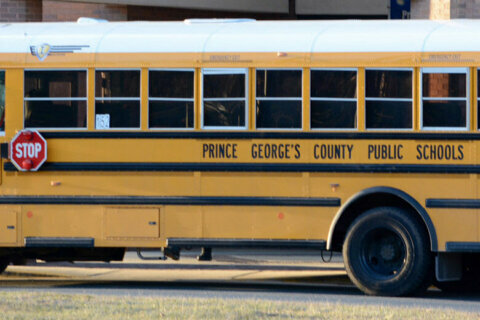A fight over what’s essentially $39 million in an already-tight Prince George’s County, Maryland, budget continues to play out in Annapolis, after members of the county’s House delegation put off a vote on two bills involving revenue streams that go into school funding.
It’s the second time in a row state lawmakers put off a decision on the matter, which pits County Executive Angela Alsobrooks against the superintendent she hired just last year, Millard House II.
The delays are causing growing frustration in Largo, where Prince George’s County leaders are drawing up two separate budgets — one with the money, and one without.
‘Draconian’ budget cuts
By law, local governments are required to spend at least as much money on education as the previous year, so the county wants to be able to use two streams of revenue that currently go directly into the school system’s budget as part of its contribution to education.
But in recent years, mandatory spending has increased rapidly, thanks to the state’s Blueprint for Maryland’s Future. And it’s putting a strain on budgets in a lot of places.
“If we get this tax revenue, we will actually use some of the tax revenue to pay for new schools and maintenance of new schools,” said Tara Jackson, the chief administrative officer in Prince George’s County. “Even if this legislation passes, the school system will receive an additional $53 million over — from the county the state — over what they had in [fiscal year 20]23.”
The county already spends more than 60% of its budget on education, and another 20% goes to public safety. And when the county first approached the school system, she said it offered to use some of the money to help pay for new schools and new school maintenance.
County leadership said they believe the school system was initially on board.
“We had an agreement with the school system. In the beginning, the school system agreed with our plan,” Jackson said. “And frankly, they reneged. And so here we are.”
No matter which budget proposal gets released, she said tax hikes or fee increases are off the table this year. Budget cuts, which she described as draconian, would hit other parts of the county’s budget.
“These are cuts that are going to impact our residents,” said Jackson. “The residents, I suspect, won’t see the level of service that they’ve been accustomed to over the last several years. Whether it’s tree trimming, or cleaning up litter on the streets, or reduced money that’s going to nonprofits that are serving our community, they will see cuts. We will have no other choice.”
The county has also been quick to point out that the cuts House has warned about -— to social services, special education and teachers -— can’t be cut because of state law. Jackson also pointed out that despite the warnings, House is proposing a $16 million increase in central office staff in the school system’s next budget.
“If they decide to spend that on something other than children, something other than the teachers, then we need to ask them why,” Jackson said. “Why is it that they have proposed to increase the budget related to their central offices, as opposed to putting money back into the classroom? That’s not a question for us. That’s the question for them.”
Parents respond
The school system did not respond to WTOP when asked to comment. But a group of parents are pressuring state lawmakers not to go forward with the proposal.
Writing for WTOP’s partner Maryland Matters, they argued “Each new Blueprint dollar means new expenses for those programs. It does not create a piggybank to relieve local politicians of their own responsibility to fully fund other expenses in our schools.”
One of the signers of that op-ed, Delores Millhouse, spoke with WTOP.
“My concern is always about the impact that’s happening in the schoolhouse,” said Millhouse, who is the vice president of the PTSA at Kettering Middle School and the chair of the PGCPS Parent and Community Advisory Council. “We’re always fighting for additional funding to close gaps.”
She said even if the cuts don’t come directly from the classroom, or teacher salaries, she worried it’ll still have a negative impact in the long run.
“We really have to stop when we use the terminology that the school system is getting, you know, tens of millions and they’re getting extra money. The economy is built on K through 12,” said Millhouse.
“We just can’t keep looking at it as, oh, that we’ve gotten enough. It will never be enough. Never. So they can find other ways and other areas in their budget, as they always do, to identify with. They need to trim the fat, and ‘trim the fat’ is not in the school system and is not on the back of our children.”
Get breaking news and daily headlines delivered to your email inbox by signing up here.
© 2024 WTOP. All Rights Reserved. This website is not intended for users located within the European Economic Area.








